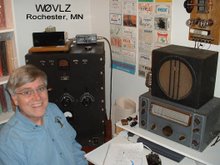As I participated in various radio events this past winter I thought about a safety issue common in budget and homebrew transmitters prior to about 1960. Many, if not most, of these transmitters used cathode keying with no regulation of the screen voltage. In these transmitters it is common to find over 100 volts across the key terminals. I measure 125 VDC at my Johnson Adventurer key terminals. Some of my friends checked their 1929 homebrew transmitters. They found as much as 191 VDC at the key terminals. All of these are basic one or two tube cathode keyed transmitters, the sort of transmitters used by many today to experience vintage tube gear.
What can be done about the high voltage at the key terminals?
- Keep your fingers off the key terminals: I've been doing this up to now. It usually works but my wife worries that it does not always work. It also follows the "If it hurts don't do it" rule.
- Covered Key Terminals: Several military keys and even some bugs are available that hide the terminals. This is a workable low tech solution but you have to find a suitable key or bug. One option today is the Bencher RJ-1 sold by Vibroplex ( http://www.vibroplex.com/contents/en-us/p202.html ).
- Mechanical Relay: Use your key or bug to operate a relay that is actually keying the rig. I've never tried this but it appears that speed may be an issue. How well does the relay keep up?
- Electronic Isolator/relay: I used a "Keyall HV" from Jackson Harbor Press / WB9KZY. The Keyall HV includes an opto-isolator and MOSFETs rated for 1000V at 3 Amps. Besides low voltage at the key terminals it is also low current so it can be used to interface a modern keyer to the heaviest of our cathode keyed boat anchors. See http://wb9kzy.com/keyallhv.htm for details.
The Keyall HV kit includes five parts and a small printed circuit card. This kit is just about as simple as one can get. Instructions are on the Jackson Harbor Press website.
I used a small aluminum utility box for my keyall housing. I could have used a smaller box but the only two battery battery holder I had was for type C flashlight batteries. The batteries needed all of the available width. I used a barrier strip for the transmitter connection because some transmitters do not have one side of the key connection grounded.
The Keyall HV interface sits in-line between my key and the transmitter. The key terminals now have less than 3 volts between them. The two C cells should be good for over 500 hours of key down time.
Monday, April 23, 2018
Subscribe to:
Comments (Atom)



